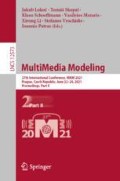Abstract
In this paper we present the case for including keystroke dynamics in lifelogging. We describe how we have used a simple keystroke logging application called Loggerman, to create a dataset of longitudinal keystroke timing data spanning a period of up to seven months for four participants. We perform a detailed analysis of this data by examining the timing information associated with bigrams or pairs of adjacently-typed alphabetic characters. We show how the amount of day-on-day variation of the keystroke timing among the top-200 bigrams for participants varies with the amount of typing each would do on a daily basis. We explore how daily variations could correlate with sleep score from the previous night but find no significant relationship between the two. Finally we describe the public release of a portion of this data and we include a series of pointers for future work including correlating keystroke dynamics with mood and fatigue during the day.
Alan Smeaton is partially supported by Science Foundation Ireland under Grant Number SFI/12/RC/2289_P2.
Access this chapter
Tax calculation will be finalised at checkout
Purchases are for personal use only
References
Bergadano, F., Gunetti, D., Picardi, C.: User authentication through keystroke dynamics. ACM Trans. Inf. Syst. Secur. (TISSEC) 5(4), 367–397 (2002)
Gaines, R.S., Lisowski, W., Press, S.J., Shapiro, N.: Authentication by keystroke timing: some preliminary results. Technical report, Rand Corp Santa Monica CA (1980)
Gurrin, C., Smeaton, A.F., Doherty, A.R.: Lifelogging: personal big data. Found. Trends Inf. Retrieval 8(1), 1–125 (2014). https://doi.org/10.1561/1500000033
Hinbarji, Z., Albatal, R., Gurrin, C.: User identification by observing interactions with GUIs. In: Amsaleg, L., Guðmundsson, G.Þ., Gurrin, C., Jónsson, B.Þ., Satoh, S. (eds.) MMM 2017. LNCS, vol. 10132, pp. 540–549. Springer, Cham (2017). https://doi.org/10.1007/978-3-319-51811-4_44
Hinbarji, Z., Albatal, R., O’Connor, N., Gurrin, C.: LoggerMan, a comprehensive logging and visualization tool to capture computer usage. In: Tian, Q., Sebe, N., Qi, G.-J., Huet, B., Hong, R., Liu, X. (eds.) MMM 2016. LNCS, vol. 9517, pp. 342–347. Springer, Cham (2016). https://doi.org/10.1007/978-3-319-27674-8_31
Jacquemard, T., Novitzky, P., O’Brolcháin, F., Smeaton, A.F., Gordijn, B.: Challenges and opportunities of lifelog technologies: a literature review and critical analysis. Sci. Eng. Ethics 20(2), 379–409 (2014). https://doi.org/10.1007/s11948-013-9456-1
Johansson, D., Malmgren, K., Murphy, M.A.: Wearable sensors for clinical applications in epilepsy, Parkinson’s disease, and stroke: a mixed-methods systematic review. J. Neurol. 265(8), 1740–1752 (2018). https://doi.org/10.1007/s00415-018-8786-y
Joyce, R., Gupta, G.: Identity authentication based on keystroke latencies. Commun. ACM 33(2), 168–176 (1990)
Kołakowska, A.: A review of emotion recognition methods based on keystroke dynamics and mouse movements. In: 2013 6th International Conference on Human System Interactions (HSI), pp. 548–555. IEEE (2013)
Koskimäki, H., Kinnunen, H., Kurppa, T., Röning, J.: How do we sleep: a case study of sleep duration and quality using data from Ōura ring. In: Proceedings of the 2018 ACM International Joint Conference and 2018 International Symposium on Pervasive and Ubiquitous Computing and Wearable Computers, pp. 714–717 (2018)
Leijten, M., Van Horenbeeck, E., Van Waes, L.: Analysing keystroke logging data from a linguistic perspective. In: Observing Writing, pp. 71–95. Brill (2019)
Leijten, M., Van Waes, L.: Keystroke logging in writing research: using Inputlog to analyze and visualize writing processes. Written Commun. 30(3), 358–392 (2013)
Meyer, J., Kay, J., Epstein, D.A., Eslambolchilar, P., Tang, L.M.: A life of data: characteristics and challenges of very long term self-tracking for health and wellness. ACM Trans. Comput. Healthcare 1(2) (2020). https://doi.org/10.1145/3373719
Shelgikar, A.V., Anderson, P.F., Stephens, M.R.: Sleep tracking, wearable technology, and opportunities for research and clinical care. Chest 150(3), 732–743 (2016)
Signal, L., et al.: Children’s everyday exposure to food marketing: an objective analysis using wearable cameras. Int. J. Behav. Nutr. Phys. Act. 14(1), 137 (2017). https://doi.org/10.1186/s12966-017-0570-3
Smeaton, A.F.: Keystroke timing information for 2,522,186 characters typed over several months. https://doi.org/10.6084/m9.figshare.13157510.v1. Accessed 29 Oct 2020
Tuovinen, L., Smeaton, A.F.: Remote collaborative knowledge discovery for better understanding of self-tracking data. In: 2019 25th Conference of Open Innovations Association (FRUCT), pp. 324–332. IEEE (2019)
Vizer, L.M.: Detecting cognitive and physical stress through typing behavior. In: CHI 2009 Extended Abstracts on Human Factors in Computing Systems, CHI EA 2009, pp. 3113–3116. Association for Computing Machinery, New York (2009)
Wang, P., Sun, L., Smeaton, A.F., Gurrin, C., Yang, S.: Computer vision for lifelogging: characterizing everyday activities based on visual semantics (chap. 9). In: Leo, M., Farinella, G.M. (eds.) Computer Vision for Assistive Healthcare, pp. 249–282. Computer Vision and Pattern Recognition, Academic Press (2018)
Author information
Authors and Affiliations
Corresponding author
Editor information
Editors and Affiliations
Rights and permissions
Copyright information
© 2021 Springer Nature Switzerland AG
About this paper
Cite this paper
Smeaton, A.F., Krishnamurthy, N.G., Suryanarayana, A.H. (2021). Keystroke Dynamics as Part of Lifelogging. In: Lokoč, J., et al. MultiMedia Modeling. MMM 2021. Lecture Notes in Computer Science(), vol 12573. Springer, Cham. https://doi.org/10.1007/978-3-030-67835-7_16
Download citation
DOI: https://doi.org/10.1007/978-3-030-67835-7_16
Published:
Publisher Name: Springer, Cham
Print ISBN: 978-3-030-67834-0
Online ISBN: 978-3-030-67835-7
eBook Packages: Computer ScienceComputer Science (R0)

